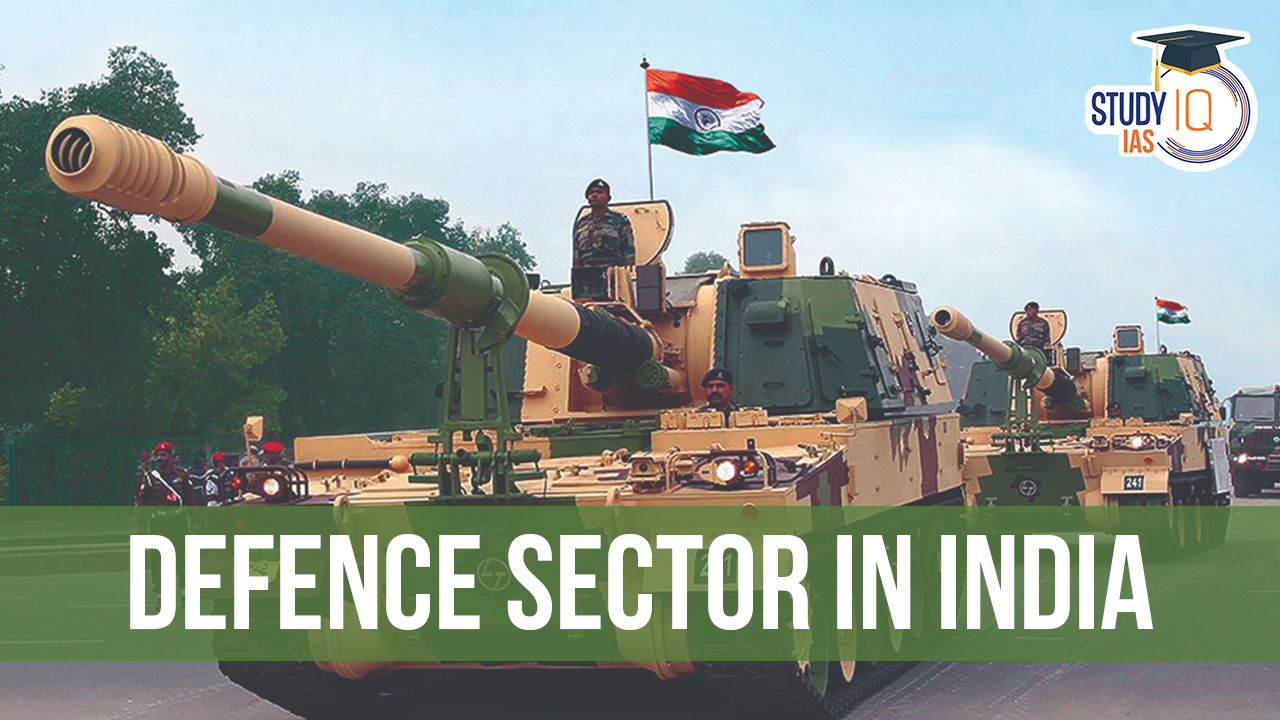Table of Contents
The Defence Sector in India plays an indispensable role in safeguarding a nation’s sovereignty and protecting its citizens. In India, a nation with a rich and complex history, the Defence sector stands as a formidable guardian of the country’s interests. Over the years, it has evolved into a vital component of India’s national security apparatus. This article delves into the intricate workings of the defence sector in India, highlighting its significance, challenges, and the strides it has made in recent years.
Defence Sector in India
The Defence sector in India is not merely a collection of armed forces; it’s a multifaceted ecosystem encompassing various branches and institutions dedicated to the country’s defense. At its core are the Indian Army, Indian Navy, and Indian Air Force, each responsible for defending different aspects of the nation—land, maritime borders, and airspace, respectively. In addition to these primary armed forces, India has paramilitary forces such as the Border Security Force (BSF), Central Reserve Police Force (CRPF), and Indo-Tibetan Border Police (ITBP) that play a crucial role in maintaining law and order, counter-terrorism efforts, and border security.
We’re now on WhatsApp. Click to Join
Components of Defence Sector in India
The Defence sector in India is a crucial part of the country’s national security apparatus. It encompasses a wide range of components, including:
| Component | Description |
| 1. Indian Armed Forces | – Army, Navy, and Air Force safeguarding territorial integrity and national security. |
| 2. Indian Coast Guard | – Protects maritime interests and enforces maritime law. |
| 3. Paramilitary Forces | – CRPF, BSF, ITBP, SSB, etc., assist in border security and internal security. |
| 4. DRDO (Defense Research and Development Organization) | – Conducts research and development in Defence technologies. |
| 5. Ordnance Factories and DPSUs | – Produces military equipment and Defence systems. |
| 6. Indian Navy and Coast Guard Shipbuilding Industry | – Manufactures naval vessels. |
| 7. Indian Air Force Equipment Manufacturing | – Domestic and international partnerships for aircraft production. |
| 8. Strategic Forces | – Land-based, sea-based, and air-based strategic forces for nuclear deterrence. |
| 9. Cyber Security and Information Warfare | – Protects critical infrastructure and military systems. |
| 10. Research and Development Institutes | – Conduct military research and training. |
| 11. Military Intelligence Agencies | – Gather, analyze, and disseminate intelligence for national security. |
| 12. Defence Procurement and Policy | – SetsDefenceprocurement policies and managesDefencebudget. |
| 13. Strategic Command Structure | – Oversees nuclear, space, and cyber warfare capabilities. |
| 14. Civil Defense | – Provides protection and support to civilians during emergencies. |
| 15. National Security Council | – Formulates and oversees national security policies. |
| 16. Border Security and Paramilitary Units | – Guard India’s land and maritime borders. |
Evolution of Defence Sector in India
The history of India’s Defence sector is a story of transformation and adaptation, marked by key events and strategic shifts that have shaped the nation’s approach to national security. From a position of under-preparedness to a growing emphasis on indigenous innovation, this narrative reveals the journey of India’s Defence sector.
1962 Indo-China Conflict
The Indo-China conflict of 1962 served as a stark wake-up call for India. It exposed the nation’s unpreparedness for war and highlighted the pressing need to bolster its Defence capabilities. In response to this wake-up call, India significantly increased its Defence expenditure, allocating 2.3% of its GDP to strengthen its military capabilities.
1965 Indo-Pak War
The 1965 Indo-Pak war brought a new dimension to India’s Defence Sector. During this period, the United States imposed an embargo on the export of arms to the warring nations. This embargo not only impacted the dynamics of the war but also prompted India to diversify its Defence ties. In response to this external challenge, India intensified its Defence relations with the Soviet Union, a partnership that would become significant in the years to come.
From Soviet Dependency to Indigenous Innovation
Over time, India’s overdependence on the Soviet Union for Defence equipment necessitated a change in approach. The nation gradually transitioned from license-based production to an emphasis on indigenous design-based production. This shift was a critical turning point in India’s quest for self-reliance in Defence manufacturing.
1980s: A Thrust in Research and Development
In the mid-1980s, the Indian government recognized the need for a substantial investment in research and development to boost indigenous Defence capabilities. Resources were channeled to support the Defence Research and Development Organization (DRDO) in undertaking high-profile Defence projects. These initiatives marked India’s determination to reduce reliance on foreign suppliers.
1983: Integrated Guided Missile Development Programme (IGMDP)
A significant milestone in India’sDefenceindigenization was reached in 1983 with the initiation of the Integrated Guided Missile Development Programme (IGMDP). This visionary program aimed to develop five missile systems:
- Prithvi (surface-to-surface)
- Akash (surface-to-air)
- Trishul (the naval version of Prithvi)
- Nag (anti-tank)
- Agni (Ballistic missiles with different ranges: Agni I, II, III, IV, V)
These missile systems not only enhanced India’s Defence capabilities but also laid the foundation for further indigenous development.
1990 Self Reliance Review Committee (SRRV)
In 1990, the Self Reliance Review Committee under the guidance of A.P.J. Abdul Kalam formulated a 10-year self-reliance plan. This plan proposed the concept of a self-reliance index (SRI), defined as the percentage share of indigenous content in total procurement expenditure. The ambitious goal was to increase the SRI from 30% in 1992-1993 to 70% by 2005. However, this target remains unattained to this day.
Co-Development and Co-Production: A New Focus
Despite commendable efforts in indigenization, it became apparent that they were insufficient to meet the armed forces’ requirements. This realization led to a strategic shift toward co-development and co-production in collaboration with foreign companies. In 1998, India and Russia entered into an inter-governmental agreement to jointly produce Brahmos supersonic cruise missiles, a significant milestone in Defence cooperation.
Global Partnerships for Defence Innovation
India has also established partnerships with other countries such as Israel and France for various Defence projects, reflecting its commitment to leveraging global expertise and technology to strengthen its Defence capabilities.
The history of India’sDefencesector is a testament to the nation’s journey from reliance on external sources to a growing emphasis on indigenous innovation and international collaborations. As India continues to evolve its Defence strategy, the sector plays a pivotal role in shaping the nation’s security landscape and its contributions to global peace and stability.
Indigenisation in Defence Sector in India
Indigenisation, a pivotal strategy, reflects a nation’s capability to design, develop, and produce Defence equipment within its borders, fostering self-reliance and reducing dependence on imports. In India, a nation with immense potential and a strategic position, indigenisation holds paramount importance for several compelling reasons.
Self-Defence
The presence of neighboring nations like China and Pakistan, with occasionally strained relations, underscores the necessity of bolstering self-defence and preparedness. Indigenisation empowers India to enhance its security, reducing vulnerability to external disruptions.
Strategic Advantage
Self-reliance in Defence technologies bolsters India’s geopolitical standing, transforming it into a net security provider. This strategic advantage not only safeguards national interests but also strengthens India’s role in promoting regional stability.
Technological Advancement
Advancements in Defence technology ripple across various industries, propelling economic growth. A robust Defence technology sector spurs innovation, creating a positive cascading effect on the broader economy. Consequently, indigenisation is a catalyst for India’s technological advancement.
Economic Efficiency
India allocates approximately 3% of its GDP to defense, a substantial portion of which goes toward imports. Indigenisation mitigates this economic drain, directing resources to domestic industries and minimizing external financial outflows.
Employment Opportunities
The pursuit of indigenisation necessitates collaboration with a myriad of auxiliary industries, generating a plethora of employment opportunities. The Defence manufacturing ecosystem becomes a source of livelihood for many, further strengthening the nation’s economic fabric.
Why Indigenisation Matters?
India, the world’s second-largest arms importer after Saudi Arabia, faces a pressing challenge – a substantial fiscal deficit exacerbated by high import dependency in the Defence sector. Despite boasting the world’s fifth-largest Defence budget, India sources a staggering 60% of its weapon systems from international markets. It’s time for India to not only address its fiscal woes but also assert its security, sovereignty, and economic interests.
Security Imperative and Technological Expertise
Indigenization in Defence is not just an economic imperative; it’s a cornerstone of national security. A robust indigenousDefenceindustry preserves vital technological expertise and fosters spin-off technologies and innovation, which are intrinsic toDefenceproduction. This is not merely a strategic choice; it’s a security imperative.
Countering Threats and Porous Borders
India’s security challenges are multifaceted, ranging from the Uri, and Pathankot, to the Pulwama attacks. These incidents underscore the urgent need for indigenization, ensuring self-sufficiency in Defence production. In a neighbourhood marked by porous borders and hostile neighbours, self-reliance is not a luxury but a necessity.
Economic Impact and Employment Generation
The Defence manufacturing sector is a potent generator of satellite industries. These ancillary industries create a ripple effect by providing employment opportunities. Government estimates indicate that a 20-25% reduction in defense-related imports could generate an additional 100,000 to 120,000 highly skilled jobs, aligning with India’s aspirations for economic growth.
Strategic Capability and Global Standing
A self-sufficient, self-reliant Defence industry elevates India’s standing in global geopolitics. It positions the nation among the top global powers, reinforcing its influence and strategic capabilities.
Fostering Nationalism and Patriotism
Indigenous production of Defence equipment cultivates a sense of nationalism and patriotism. This not only instills trust and confidence in the Indian armed forces but also nurtures a profound feeling of integrity and sovereignty among the populace. It’s an affirmation of the nation’s ability to protect its interests and defend its sovereignty.
India’s Advancements in Indigenous Defence
India has made remarkable progress in indigenousDefencedevelopment:
- INS Vikrant: The first homegrown aircraft carrier, INS Vikrant, reflects India’s naval engineering prowess.
- Tejas Aircraft: Challenges in developing the Kaveri engine underline the need for self-reliance in high-tech defense.
- Project-75: A collaborative effort to build six advanced submarines demonstrates India’s commitment to maritime strength.
- Dhanush Artillery: An indigenous long-range artillery gun sourcing 81% of its components locally.
- Arihant Submarine: India’s first indigenous nuclear submarine, developed in partnership with BARC and DRDO.
- AGNI V: India’s status as an ICBM holder since 2013, along with other indigenous missile projects.
- Cutting-Edge Projects: Achievements like Pinaka, BRAHMOS, and the Arjun Tank showcase India’s capabilities.
Atmanirbhar in Defence Production
India’s pursuit of self-reliance in Defence is evident in a series of measures and initiatives. The latest list of 928 items emphasizes import substitution, promoting local production for fighter jets, trainer aircraft, warships, and ammunition. This shift aims to reduce import dependence and boost the domestic Defence industry. India has imposed phased import bans on various weapons and platforms, demonstrating a commitment to indigenization.
Efforts include setting aside significant funds for domestic procurement, increasing foreign direct investment to 74%, and establishing two Defence industrial corridors in Uttar Pradesh and Tamil Nadu. These corridors facilitate Defence manufacturing and exports by providing infrastructure and incentives. India has also launched the Defence Innovation Organization (DIO) to foster innovation and collaboration in the Defence sector. The Defence Production and Export Promotion Policy (DPEPP) targets a $25 billion turnover in Defence manufacturing by 2025, with a $5 billion export goal. India’s Defence exports reached a record high of ₹16,000 crore in 2022-23, reflecting a growing presence in the global market, exporting to around 85 countries.
Challenges in Defence sector in India
- Budget Constraints: Limited Defence expenditure as a percentage of GDP hampers modernization efforts.
- Obsolete Equipment: Aging military hardware reduces operational readiness and effectiveness.
- Bureaucracy and Red Tape: Sluggish procurement processes result in delays and inefficiencies.
- Lack of Indigenous Technology: Reliance on foreign technology for critical systems limits self-reliance.
- Research and Development Delays: Slow progress in indigenous technology development affects innovation and capability deployment.
- Corruption: Corruption in Defence procurement leads to cost overruns and substandard equipment.
- Geopolitical Challenges: Ongoing tensions with neighbouring countries require a robust Defence posture.
- Border Security and Terrorism: Perpetual threats from insurgent groups and terrorism demand heightened vigilance.
- Human Resources and Training: Attracting and retaining skilled personnel is a constant challenge.
- Cyber security: Growing cyber threats necessitate improved security measures for sensitiveDefencedata.
- Environmental and Climate Factors: Climate change impacts on infrastructure and readiness need consideration.
- Logistical Challenges: Maintaining supply chains in remote areas poses logistical difficulties.
- Inter-Service Coordination: Ensuring harmony among armed forces can be complex due to rivalries.
- Export Regulations: Restrictions from other nations can limit access to critical Defence technologies.
- Public Perception and Accountability: Secrecy can lead to public mistrust and concerns about transparency and accountability. Addressing these challenges is vital for India’sDefencesector to effectively safeguard national security.
Defence Sector in India UPSC
The Defence sector in India is a multifaceted ecosystem that includes the Army, Navy, and Air Force, along with paramilitary forces, research organizations like DRDO, and Defence manufacturing units. Over the years, India has evolved from foreign equipment reliance to an emphasis on indigenous innovation and global collaborations. Achievements like the INS Vikrant aircraft carrier, Tejas aircraft, and indigenous missile projects highlight progress. The pursuit of self-reliance in Defence is crucial due to security imperatives, economic impact, and technological advancement. Despite significant strides, challenges such as budget constraints, bureaucratic red tape, and geopolitical tensions persist, requiring ongoing attention and innovation.


 AI and its Regulation in India, Limitati...
AI and its Regulation in India, Limitati...
 Tuberculosis (TB), Symptoms, Causes and ...
Tuberculosis (TB), Symptoms, Causes and ...
 Silicon Photonics Enables Low-power AI A...
Silicon Photonics Enables Low-power AI A...





















